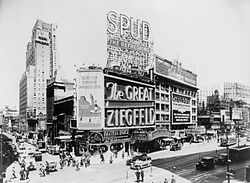 The Astor Theatre in 1936 | |
 Interactive map of Astor Theatre | |
| Address | 1537 Broadway Manhattan, New York United States |
|---|---|
| Coordinates | 40°45′30″N73°59′9″W / 40.75833°N 73.98583°W |
| Type | Broadway |
| Construction | |
| Opened | September 21, 1906 |
| Closed | 1972 |
| Demolished | 1982 |
| Years active | 1906–1925 (live theater) 1925–1972 (movie theater) |
| Architect | George Keister |
The Astor Theatre was located at 1537 Broadway, at the corner with 45th Street, on Times Square in Midtown Manhattan, New York City. It opened on September 21, 1906, with Shakespeare's A Midsummer Night's Dream [1] and continued to operate as a Broadway theatre until 1925. It then operated as a movie theater, showing first runs of films, until it closed in 1972.